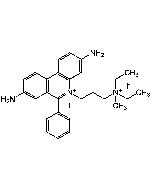Cookie Policy: This site uses cookies to improve your experience. You can find out more about our use of cookies in our Privacy Policy. By continuing to browse this site you agree to our use of cookies.
Chemodex
Propidium Iodide Solution

| Product Details | |
|---|---|
| Synonyms | 3,8-Diamino-5-(3-diethylaminopropyl)-6-phenylphenanthridinium iodide methiodide |
| Product Type | Chemical |
| Properties | |
| Formula | C27H34I2N4 |
| MW | 668.39 |
| CAS | 25535-16-4 |
| Source/Host Chemicals | Synthetic. |
| Purity Chemicals | ≥94% (HPLC) |
| Appearance | Slightly red liquid. |
| Solubility | Soluble in water. |
| Concentration | 1mg/ml in water. |
| Identity | Determined by NMR. |
| Declaration | Manufactured by Chemodex. |
| Other Product Data |
Click here for Original Manufacturer Product Datasheet |
| InChi Key | XJMOSONTPMZWPB-UHFFFAOYSA-M |
| Smiles | [I-].[I-].CC[N+](C)(CC)CCC[N+]1=C(C2=CC=CC=C2)C2=C(C=CC(N)=C2)C2=C1C=C(N)C=C2 |
| Shipping and Handling | |
| Shipping | AMBIENT |
| Short Term Storage | +4°C |
| Long Term Storage | -20°C |
| Handling Advice | Protect from light and moisture. |
| Use/Stability | Stable for at least 2 years after receipt when stored at -20°C. |
| Documents | |
| Product Specification Sheet | |
| Datasheet |
 Download PDF Download PDF |
Most common red-fluorescent nuclear stain. Membrane impermeant and generally excluded from viable cells. It can easily penetrate dead or damaged cells and as such is commonly used for identifying cell viability in a population or as a counterstain in multicolor fluorescent techniques. It binds to DNA and RNA by intercalating between the bases. Suitable for use in fluorescence microscopy, confocal laser scanning microscopy, flow cytometry and fluorometry. Spectral data: λex=488-535nm, λem=617nm.
(1) J. Fried et al.; J. Cell Biol. 71(1), 172 (1976) | (2) (4) G. Ciancio et al.; Cytometry 14(2), 205 (1993) | (3) D.M. Coder; Curr. Protoc. Cytom. Suppl. 15 9.2.1-9.2.14 (1997) | (4) C. Foglieni et al.; Histochem. Cell Biol. 115(3), 223 (2001) | (5) T. Kovacs et al.; Cytometry, Part A 73A(10), 965 (2008) | (6) M.K. Gould et al.; Anal. Bioche. 382(2), 87 (2008)






